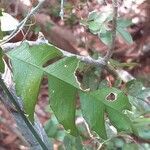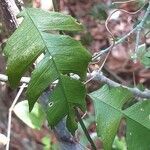Small liana or subscandent shrublet to 3 m., glabrous, with perennial rootstock; older stem corky, shoots often lenticellate.. Tendrils 3–10(–15) cm.. Leaf-blades variable (heterophyllous), elliptic to lanceolate or linear-lanceolate, top acute to long-acuminate, base acute to attenuate, margin entire or regularly to irregularly dentate, or leaves pinnately lobed to various depth, the lobes acute to rounded, 2.5–13 by 0.7–4.5 cm.; leaves on saplings, sterile or juvenile shoots often lanceolate to linear, ± deeply pinnately lobed, the lobes broad or narrow, 10–30 by 0.2–2 cm.; petioles 4–12 mm., on juvenile plants 0–4 mm.; glands on petiole absent or 1(–2) pairs at the top; glands on blade-margin several, minute, mostly at the tips of the teeth; stipules subtriangular to linear, ± 0.5 mm.. Inflorescences 1–3-flowered; bracts subtriangular, 0.5–1 mm.. Flowers glabrous; stipe 6–25 mm.. Hypanthium shallowly cup-shaped, ± 3–4.5 mm. wide.. Sepals elliptic to oblong, obtuse, 6–11 by 3–6 mm.. Petals elliptic to oblong, obtuse, 5–10 mm. long.. Corona 5–8 mm. high, composed of threads ± connate at base into a tube 0.5–2 mm., free parts of threads 4–6 mm., inside tube and at base of free threads a zone of short hair-like appendages 0.5– 1 mm.. Androgynophore ± 1 mm... Filaments 6–10 mm., connate at base into a cup ± 1 mm., often with small lobes on its margin in between the filaments; anthers 2–3 mm.. Gynophore 2–2.5 mm.; ovary 2–2.5 mm., ± (3–)4-angled; style 1.5–2 mm.; stigma 2–2.5 mm. across.. Fruit ellipsoid-oblong, acute (fusiform), excluding the ± 1 cm. long gynophore 4.5–5 by 2.5–3 cm.. Seeds rather few, ellipsoid, ± 8 mm.. Fig. 9.
Leaves coriaceous, with the nerves and veins prominent on both faces, those of saplings and juvenile shoots 10–21 × 0·4–1·1 cm., linear, pinnatipartite with the segments obliquely triangular; leaves on sterile adult branches 4–10(12) × 1–4·5(6) cm., entire, elliptic or oblong, acute or sometimes acuminate at the apex, cuneate at the base, or irregularly pinnatipartite or divided to the midrib; leaves of floriferous branches 4–7 × 1·5–3·5 cm., elliptic, acute or obtuse at the apex, entire or with a few fairly deep divisions, strongly undulate at the margin; petiole 7–12 mm. long, with a pair of glands at the top.
Ovary c. 2·5 × 2 mm., ovoid, on a swollen gynophore c. 3 mm. long; style c. 1·5 mm. long, thick, crowned by a (3)—4-lobed stigma c. 2·5 mm. in diameter.
Flowers c. 1·5 cm. long and c. 2 cm. in diameter, white, odoriferous, solitary or in axillary fascicles; pedicels c. 5 mm. long.
Sepals 7–9 × 3–5 mm., ovate or broadly oblong, obtuse or acute, with very distinct reticulation.
Climber or sparsely-branched shrub up to 3 m. high, glabrous, showing conspicuous heterophylly.
Stamens with filaments c. 10 mm. long, shortly connate at the base; anthers c. 4 mm. long.
Petals similar to the sepals, but smaller, narrower and of a thinner texture.
Corona with the tube 2·5–3 mm. high and the threads c. 4 mm. long.
Tendrils axillary, slender to stout, 3–10(15) cm. long.
Hypanthium very short, c. 5 mm. wide.
Capsule 4·5–5 × 2·5 cm., many-seeded.
Seeds c. 6·5 × 4 × 2·5 mm., pyriform.



